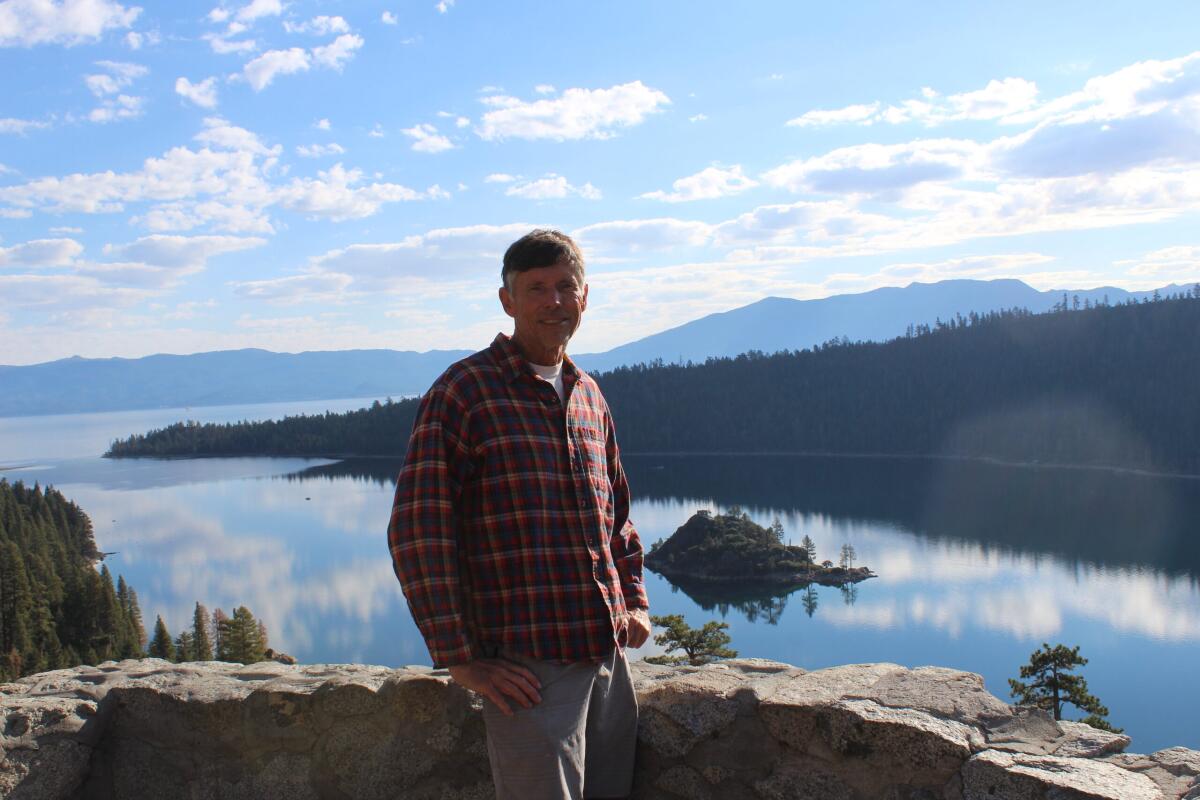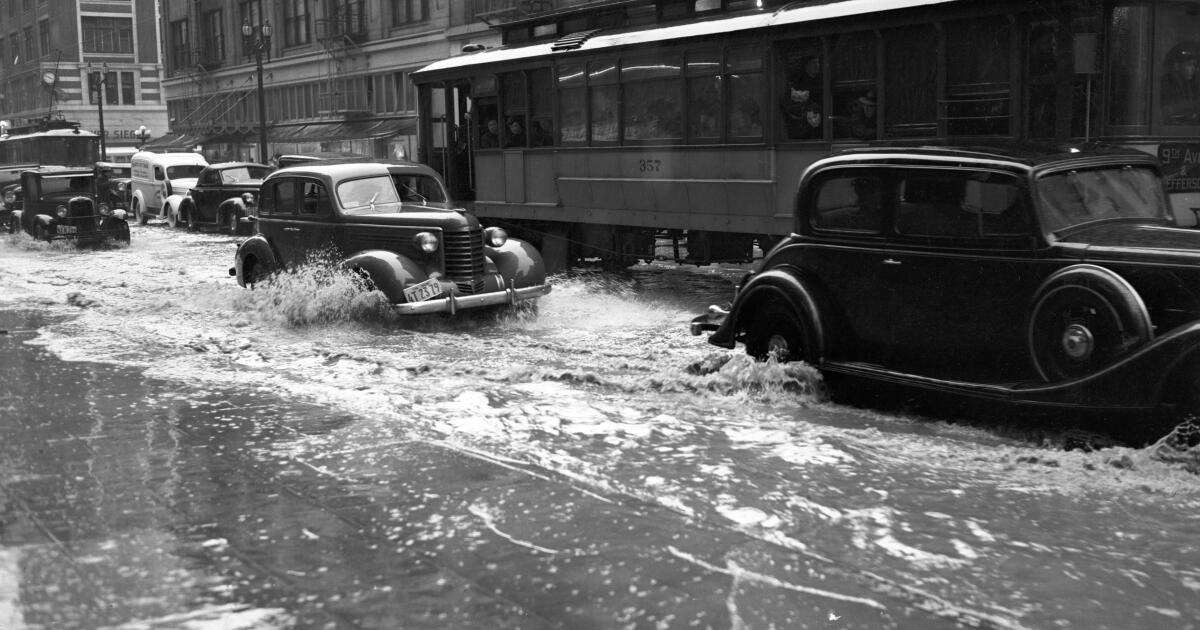Book Review
The California Sky Watcher: Understanding Weather Patterns and What Comes Next
By William A. Selby
Heyday Books: 384 pages, $30
If you buy books linked on our site, The Times may earn a commission from Bookshop.org, whose fees support independent bookstores.
The winter before last, my wife and I were driving back to L.A. from Mammoth when our car began veering across the lane markers as dust devils rose from the desert floor. We were in an Antelope Valley windstorm.
A barely visible 18-wheeler about 100 yards ahead of us suddenly toppled over. By the time we had crept through the storm, we had counted at least a dozen more semis lying on the shoulder like tipped cows.
What had caused such violent winds? Did we miss any warning signs? Was such strange weather in fact remarkably common?
William A. Selby’s comprehensive account of California’s varied meteorological phenomena, multitudinous microclimates and seasonal extremes, “The California Sky Watcher: Understanding Weather Patterns and What Comes Next,” solves many such mysteries of the climate that creates — and is created by — the state’s landscape and civilization.
Raised in Santa Ana, Selby is a retired Santa Monica College professor who has conducted research for the National Weather Service. His latest book, complete with helpful, dizzying and sobering diagrams and photographs, could easily serve as the text for a college earth science course. It takes a thoroughly empirical approach to California’s four seasons and their manifestation across its myriad topographies.
Selby demands a lot of his readers from the get-go: In the introduction, he offers a primer on the fundamental physics of atmospheric science, suggesting that most of what follows won’t make much sense without it. Some readers might be unpleasantly reminded of the days when they were graded on their ability (or inability) to grasp such concepts. But those who muscle through the book’s occasional pedantry — often regarding the negotiations between air masses and geographic formations — will gain a better appreciation of the epic forces contributing to California’s alternately eerie, chaotic and idyllic weather. And those most familiar with the state’s unique climate will be more likely to share Selby’s fascinations.
The science here is most compelling when Selby spins thermal columns, updrafts, trade winds and cloud formations into a history of California’s cities and often manmade geography. He tracks an annual winter cyclone pattern from the North Pacific all the way down to Orange County to tell the story of the 1938 flood, the consequences of which are still evident today. Up to 30 inches of rain in less than a week led to more than 100 deaths and a host of flood control measures, an overreaction that paved river channels and obliterated L.A.’s riverside habitats (and didn’t even fix the flooding problem). To this day, we’re still spending money to remove that concrete and restore lost riparian ecosystems.
Selby aims not only to explain the science of the state’s weather but also to demonstrate its ubiquitous influence on our history and society. His examples range from quotidian comedy to bizarre criminality.
He laments, for example, how San Francisco’s summertime fog and swirling winds resulted in four decades of disastrously entertaining Giants baseball, defined by freezing fans and fly balls thrown unexpectedly off course. The franchise relocated from wind-whipped Candlestick Point to a basin shielded by hills in 2000 — and finally started winning championships.
The state’s weather has also influenced its industry, including the less legitimate sectors. In Northern California’s Emerald Triangle, known for its marijuana farms, clandestine cannabis growers have taken advantage of heavy rainfall and dense forests to illegally reroute water courses. The notion might seem comical at first, but these rogues have poisoned natural ecosystems with chemicals and even murdered civilians and bandits perceived as threats.
Selby thus relates the state’s weather to its people — who may act in accordance with or, more interestingly, in defiance of it — offering respite from the book’s drier passages.
His greatest gift to readers is to reveal the climate as an indomitable equalizer. He consults great wordsmiths such as Joan Didion, Joni Mitchell and Annie Dillard to convey the fear and awe that California weather inspires. Patience and perseverance through the book’s atmospheric science pays off: When Selby concludes, “Earth’s natural rhythms, cycles, and systems will always rule our lives in the long run,” we know just how true this is. And a sky watcher should wax philosophical every once in a while.
In the book’s final chapter, on climate change, Selby juxtaposes early settlers’ primitive or nonexistent means of forecasting the weather with today’s mind-blowing technologies. He notes that although more and more Californians live on disaster-prone terrain, the number of lives lost to weather-related disasters has dropped, thanks partly to the availability of such information. If I’ve ever taken my weather app for granted, I won’t do so again anytime soon.

Now about that windstorm. A relatively stable air mass blows from southwest to northeast over the Transverse Ranges north of L.A. That air rushes down the northern side of the mountains as if on a roller coaster, reaching such velocity that it drops below its level of equilibrium and blasts across the desert floor. To compensate for this sudden change, the winds loop back toward the mountains and mix with the remaining stable air mass, creating oscillations that animate dust storms.
As dramatic and frightening as it was to experience, it’s an annual occurrence that wreaks regular havoc across the desert. Fortunately, we made it back safely to L.A. and a windless, 62-degree day in the middle of February. Behold, the Golden State.
Daniel Vitale is a writer in Los Angeles and the author of the novel “Orphans of Canland.”







